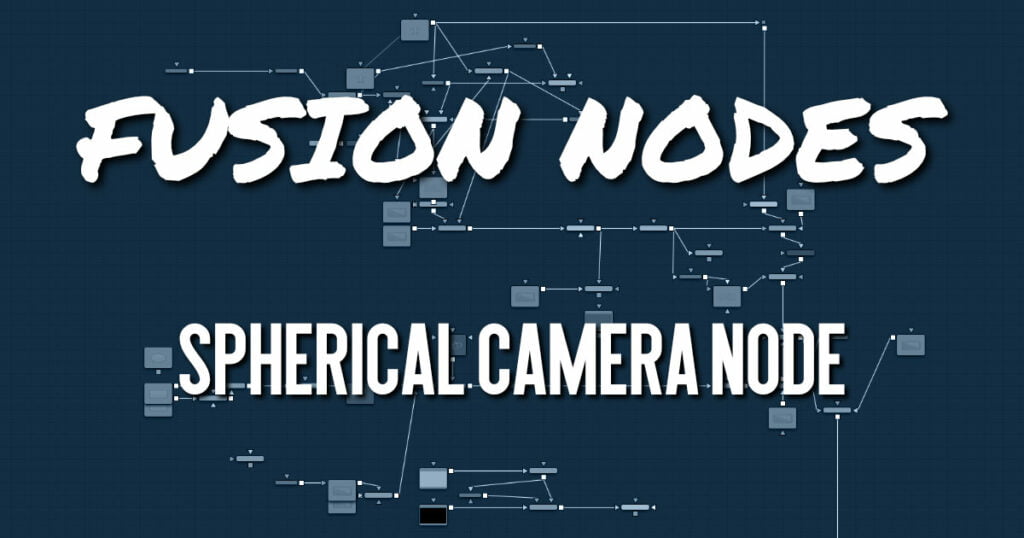
The Spherical Camera allows the 3D Renderer node to output an image covering all viewing angles, laid out in several different formats. This image may be used, for example, as a skybox texture or reflection map or viewed in a VR headset. The Image Width setting in the 3D Renderer sets the size of each square cube face, so the resulting image may be a multiple of this size horizontally and vertically.
Spherical Camera Node Inputs
The Spherical camera node has two inputs.
- Image: This orange image input requires an image in a spherical layout, which can be any of LatLong (2:1 equirectangular), Horizontal/Vertical Cross, or Horizontal/Vertical Strip.
- Stereo Input: The green input for a right stereo camera if you are working in stereo VR.
- Neither input is required.
Spherical Camera Node Setup
In many ways, the Spherical Camera is set up identically to the regular Camera 3D node. The output of the camera connects into a Merge 3D. Typically, the Merge 3D has an image from a LatLong or H Cross/V Cross formatted image either directly or through a Panomap node. The image is wrapped around a sphere, and the camera is placed inside the sphere.
Spherical Camera Node Controls Tab
- Layout
- VCross and HCross: VCross and HCross are the six square faces of a cube laid out in a cross, vertical or horizontal, with the forward view in the center of the cross, in a 3:4 or 4:3 image.
- VStrip and HStrip: VStrip and HStrip are the six square faces of a cube laid vertically or horizontally in a line, ordered as Left, Right, Up, Down, Back, Front (+X, -X, +Y, -Y, +Z, -Z), in a 1:6 or 6:1 image.
- LatLong: LatLong is a single 2:1 image in equirectangular mapping.
- Near/Far Clip
The clipping plane is used to limit what geometry in a scene is rendered based on the object’s distance from the camera’s focal point. This is useful for ensuring that objects that are extremely close to the camera are not rendered and for optimizing a render to exclude objects that are too far away to be useful in the final rendering.
The default perspective camera ignores this setting unless the Adaptively Adjust Near/Far Clip checkbox control below is disabled.
The values are expressed in units, so a far clipping plane of 20 means that any objects more than 20 units from the camera are invisible to the camera. A near clipping plane of 0.1 means that any objects closer than 0.1 units are also invisible. - Adaptively Adjust Near/Far Clip
When selected, the Renderer automatically adjusts the camera’s near/far clipping plane to match the extents of the scene. This setting overrides the values of the Near and Far clip range control described above. This option is not available for orthographic cameras. - Viewing Volume Size
The Viewing Volume Size control appears only when the Projection Type is set to Orthographic. It determines the size of the box that makes up the camera’s field of view. The Z distance of an orthographic camera from the objects it sees does not affect the scale of those objects, only the viewing size does. - Plane of Focus (for Depth of Field)
This value is used by the OpenGL renderer to calculate depth of field. It defines the distance to a virtual target in front of the camera. - Stereo Method
This control allows you to adjust your stereoscopic method to your preferred working model. - Toe In
Both cameras point at a single focal point. Though the result is stereoscopic, the vertical parallax introduced by this method can cause discomfort by the audience. - Off Axis
Often regarded as the correct way to create stereo pairs, this is the default method in Fusion. Off Axis introduces no vertical parallax, thus creating less stressful stereo images. - Parallel
The cameras are shifted parallel to each other. Since this is a purely parallel shift, there is no Convergence Distance control. Parallel introduces no vertical parallax, thus creating less stressful stereo images. - Eye Separation
Defines the distance between both stereo cameras. If the Eye Separation is set to a value larger than 0, controls for each camera are shown in the viewer when this node is selected. There is no Convergence Distance control in Parallel mode. - Convergence Distance
This control sets the stereoscopic convergence distance, defined as a point located along the Z-axis of the camera that determines where both left and right eye cameras converge. - Control Visibility
Allows you to selectively activate the onscreen controls that are displayed along with the camera.- Frustum: Displays the actual viewing cone of the camera.
- View Vector: Displays a white line inside the viewing cone, which can be used to determine the shift when in Parallel mode.
- Near Clip: The Near clipping plane. This plane can be subdivided for better visibility.
- Far Clip: The Far clipping plane. This plane can be subdivided for better visibility.
- Plane of Focus: The camera focal point according to the Plane of Focus slider explained above. This plane can be subdivided for better visibility.
- Convergence Distance: The point of convergence when using Stereo mode. This plane can be subdivided for better visibility.
Spherical Camera Node Settings Tab
The Settings tab in the Inspector is duplicated in other 3D nodes. These common controls are described in detail HERE










